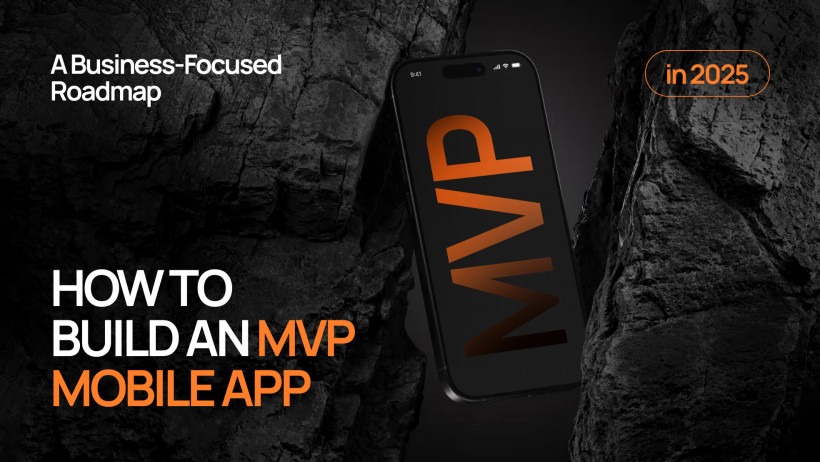You’ve sketched the app, you see the potential but reality hits: What if no one uses it? What if the budget runs out before launch? What if competitors beat you to market? These doubts stop many founders before they even begin.
That’s why launching a minimum viable product mobile app is the smartest way to move forward. It gives you a real-world testing ground, where you can see how users interact with your idea, what features matter most, and which assumptions need to be rethought. Instead of investing huge amounts of time and money upfront, an MVP allows you to validate your concept, gather honest feedback, and adapt quickly without burning through resources.
In 2025, with markets moving at lightning speed and competition intensifying, time-to-market and user feedback have become more critical than ever. New apps appear daily, and those who wait too long to launch often miss their opportunity. Building an MVP isn’t just about saving costs, it’s about gaining clarity, reducing risk, and paving the way for future success. Think of it as your startup’s early compass: it points you in the right direction, helps you avoid costly detours, and gives you the confidence to scale when the time is right.
What Is an MVP in Mobile App Development?
An MVP app is a simplified version of your product that focuses only on the most essential features. Think of it as the “core skeleton” of your idea — lean, functional, and ready to be tested in the real world. Its main purpose is not perfection, but validation: to see how real users interact with it, gather early feedback, and determine if there’s genuine demand for your solution.
- MVP vs prototype vs full product: A prototype is like a sketch, it helps you visualize the concept, often through wireframes or clickable mockups, but it doesn’t solve problems for users. An MVP goes a step further, it’s a functioning product with just enough capability to let users experience its core value. A full product comes only after validation, when you’ve proven that the concept works and you’re ready to scale with more advanced features and infrastructure.
- Why MVPs help reduce risk: Instead of building everything at once and hoping it will work, you focus on essentials. This approach minimizes wasted time and money if the idea fails to resonate, while also giving you the flexibility to pivot if user feedback points in a different direction. In short, it transforms uncertainty into learning opportunities.
Benefits of Building an MVP App

Why do so many startups embrace MVPs? Because the benefits go far beyond cost savings. An MVP is a smart strategy for learning, adapting, and building a foundation for sustainable growth.
- Faster time to market – launch your app quickly, test your assumptions in the real world, and gain a competitive edge while others are still planning.
- Budget efficiency – instead of spreading resources thin across dozens of features, you focus on what truly matters. This lean approach minimizes waste and maximizes impact.
- Early user feedback – get real insights from actual users, discover what they love, what they ignore, and what frustrates them before it’s too late or too expensive to change.
- Better investor traction – a working MVP proves your seriousness. It’s far more convincing to show investors a product in action than just a slide deck. This credibility can open doors to funding and partnerships, especially for those exploring technology investing opportunities.
- Lower overall risk – by validating step by step, you protect yourself from building a product nobody needs. Every iteration reduces uncertainty and brings you closer to product-market fit.
Defining Your MVP Goals
Before writing a single line of code, clarity is key.
- Who is your target user? Clearly define the audience that will benefit from your solution.
- What core problem are you solving? Keep it focused — an MVP should address one main pain point effectively.
Setting measurable goals, such as “acquire 500 early users in 3 months” or “achieve 30% retention after 4 weeks,” will keep your MVP development on track.
Feature Prioritization for MVP
When it comes to startup MVP development, not every feature makes the cut. In fact, one of the hardest (but most important) decisions is knowing what to leave out. A clear system for separating the essentials from the extras ensures your MVP remains focused and impactful.
- Must-have vs nice-to-have: Ask yourself, “If this feature didn’t exist, would the app still solve the core problem?” If the answer is yes, it’s a “nice-to-have.” If the answer is no, it’s a “must-have.”
- Tools for prioritization: Frameworks like MoSCoW (Must, Should, Could, Won’t) or the Kano Model help structure these decisions. They give you a way to balance business goals with user satisfaction, instead of guessing.
- Avoid feature creep: It’s tempting to add more functionality early on, but remember — every extra feature delays launch and adds complexity.
The goal is to create a lean product that still delivers real value. Less is more when building your first version, and having a clear MVP mobile app roadmap helps you stay focused on essentials without losing sight of long-term growth.
Designing an MVP-Friendly UX
User experience can make or break your MVP. Even with minimal features, users expect intuitive design.
- Keep it intuitive: Don’t overwhelm users, focus on simple navigation and clear actions.
- Focus on the primary use case: Every screen and interaction should guide users toward solving the core problem.
Good UX for MVP is about clarity, not complexity.
Development Process of an MVP
Building an MVP is as much about strategy as it is about coding.
- Choosing the right tech stack: Pick tools that are flexible, scalable, and cost-effective.
- In-house vs outsourced team: Decide whether you want the control of an in-house team or the efficiency of outsourcing.
- Agile and iterative development: Adopt the lean startup methodology and agile mobile development to release in short cycles, test, and improve continuously.
An effective app development lifecycle for MVPs is all about speed, learning, and adaptability.
Testing and Validating Your MVP
Launching an MVP isn’t the finish line, it’s the beginning of learning.
- Metrics to watch: Track retention rates, engagement levels, and user satisfaction.
- Gathering and acting on user feedback: Use surveys, interviews, and in-app analytics to learn what users want next.
App testing for MVP ensures you’re not just shipping an app but building a foundation for success.
What Comes After the MVP?
So you’ve launched your MVP, what’s next? This is the stage where the real journey begins. An MVP isn’t the end goal; it’s a launchpad that helps you decide where to go next.
- Pivot, iterate, or scale – based on user feedback, you may need to adjust your strategy, refine core features, or double down on what’s working. Sometimes that means pivoting toward a different market segment, other times it’s about improving functionality and usability.
- Preparing for full product launch – once your MVP gains traction, it’s time to strengthen your infrastructure, expand features, and polish the user experience. This ensures your product can handle more users, higher expectations, and real growth.
This stage is where early-stage validation evolves into sustainable growth. By analyzing data, listening to your users, and making smart decisions, you transform your MVP from a test project into a scalable product with a clear future.
How WEZOM Helps Launch MVPs That Scale

At WEZOM, we don’t just build apps, we become your strategic partner in bringing bold ideas to life. Our approach to MVP app development 2025 combines deep technical expertise with a clear understanding of business goals, ensuring that every MVP is not only functional but also ready to grow.
Discovery sessions
We work closely with you to define goals, identify your target users, and prioritize core features. This step lays the foundation for clarity and direction.
MVP architecture and design
Our team creates scalable, user-friendly solutions that balance sleek design with practical functionality, making sure your app is both intuitive and future-proof.
Scalable development roadmap
We align your MVP with a clear plan for future iterations, helping you move from early-stage validation to a full product launch without unnecessary detours.
With WEZOM, your journey to building a minimum viable product mobile app becomes less about guesswork and more about measurable progress. You’ll launch faster, learn from real users, and have a roadmap that supports long-term success.

Conclusion
Building an MVP is about learning fast and growing smart. In 2025, with user expectations higher than ever, the right MVP strategy can mean the difference between a successful launch and a wasted investment. An MVP is your testing ground, your proof of concept, and your first step toward long-term growth.
By focusing on your target audience, prioritizing features that truly solve their problems, and iterating quickly, you’ll move closer to achieving product-market fit. Each cycle of feedback and improvement not only sharpens your app but also builds trust with users and investors alike. And when the time comes to scale, you won’t just be guessing, you’ll have real data, proven traction, and the confidence to expand.
If you’ve been wondering how to build an MVP app that balances speed, efficiency, and user value, the key lies in starting small, learning constantly, and scaling strategically. Launching your MVP is more than a technical process; it’s a mindset. It’s about embracing agility, staying curious, and being willing to adapt.
Ready to bring your idea to life? Let’s build an MVP that grows with your vision and sets the stage for long-term success.

